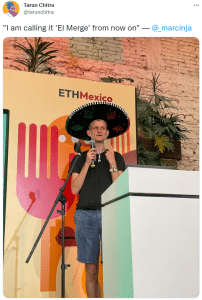August 25, 2022 / Unchained Daily / Laura Shin
Daily Bits✍️✍️✍️
- Tether sticks to its decision not to freeze Tornado Cash addresses, at least for now.
- The Bellatrix upgrade, the first of the two before the Merge, is scheduled for September 6.
- Sam Trabucco steps down as Alameda Research co-CEO.
- Jordan Fish, most commonly known as Cobie, donated 100,000 USDC to Atozy, the YouTuber who was sued by BitBoy Crypto, who later announced he would drop the suit.
- The Ontario Securities Commission (OSC) issued an alert flagging 13 companies that “are not registered to deal or advise in securities in Ontario,” including Kucoin.
- Former SEC Chair Jay Clayton joined crypto-focused VC firm Electric Capital as an advisor.
- A judge in the Netherlands ruled that Alexey Pertsev, the developer arrested after the Tornado Cash sanctions, must stay in jail for at least 90 days.
- Blockchain analytics firm Elliptic reported that $100 million was stolen in NFTs during the last year.
- Alleged Bitcoin launderer Heather “Razzlekhan” Morgan broke a long silence on Twitter to deny any links to crypto projects using her name.
- Republican Representative Lauren Boebert failed to disclose crypto transactions in 2021.
Today in Crypto Adoption…
- M&M’s will release a limited edition of BAYC-inspired candies.
- Beijing released a new plan for the introduction of metaverse technologies in the city’s new innovation zones.
- Neopets, the classic virtual online pets game, will launch its metaverse version on Friday.
The $$$ Corner…
- Haun Ventures led a $24 million round into Web3 developer platform Thirdweb.
What Do You Meme?
What’s Poppin’?
Ahead of the Merge, Coinbase Launches Its Liquid Staking Derivative
Yesterday, Coinbase announced it would be launching cbETH, a liquid staking derivative of ETH.
“Keeping Ethereum secure and decentralized is critical to Coinbase’s mission and our hope is that cbETH contributes to that cause,” said the crypto exchange.
Under Ethereum’s current state of Proof of Stake, if you decided to stake ETH on your own, your tokens would be locked up until the Shanghai upgrade, which will happen only several months after the Merge.
Here is where liquid staking comes in: It allows you to stake your ETH and earn rewards while still being able to use the funds. The most widely used liquid staking token is stETH, the token that represents staked ETH with Lido. Lido’s power has been addressed as a concern by community leaders because of its market dominance, which threatens the decentralization of the network. This topic was covered extensively by Unchained here and here.
Coinbase laid out a whitepaper explaining all the details on cbETH:
- Coinbase Wrapped Staked ETH (cbETH) is a utility token that represents ETH2, which is ETH staked through Coinbase.
- cbETH will use a cToken model, first introduced by DeFi protocol Compound. Under this model, the tokens represent ownership of the underlying principal plus any rewards accrued on that principal, minus any penalties.
- Three examples of use cases for cbETH:
- Exiting staked ETH.
- Using it as collateral in DeFi applications.
- Transferring staked ETH.
One important thing to highlight is that cbETH is not supposed to be pegged on a 1:1 ratio with ETH. This was one of the major misconceptions about stETH when it “de-pegged” a few months ago. On this issue, Coinbase explained: “ETH and cbETH are not pegged or expected to be interchangeable 1:1. In fact, as the underlying staked ETH continues to accrue rewards, each cbETH token is expected to represent more staked ETH, which may result in divergence in prices for these assets over time.”
As for whether or not it is an alternative to Lido that could prevent Ethereum from becoming centralized, at least one community member believes it will not resolve that issue. Ethereum investor Ryan Berckmans tweeted, “Lido’s stETH is monopolistic and erodes Eth’s decentralization. Coinbase’s stETH is highly centralized and in the US. Rocket Pool’s rETH is neither.”
On a related note, Coinbase addressed the issue of slashing (the topic of yesterday’s newsletter). The company stated that it is taking measures to mitigate the risk of breaking the rules of Ethereum’s consensus mechanism to avoid getting slashed, such as client diversification, node operator diversification, and geographical diversification.
Recommended Reads
- Arthur Hayes on USD liquidity conditions and how it affects assets
- Cumberland on Ethereum dynamics after the Merge
- noxx on arbitrage profits
On The Pod…

Stephane Gosselin, cofounder and chief architect of Flashbots, and Uri Klarman, CEO of bloXroute Labs, joined Unchained to discuss everything about MEV, an especially important topic now with the Merge coming. Show highlights:
- what MEV is, how it works under Proof of Work
- some examples of MEV, like frontrunning and arbitrage
- how MEV is a rabbit hole full of monsters
- the role of Flashbots in the MEV industry and how Flashbots enabled a reduction of gas fees for users
- how MEV-geth functions and how it relates to auctions systems
- how bloXroute, Uri’s company, is working with MEV
- where Stephane and Uri disagree on MEV, despite agreeing on many fundamental things
- how MEV changes with the implementation of Proof of Stake
- what MEV-Boost is and the problems it solves
- what proposer-builder separation is and the motivation behind this idea
- whether DeFi would flourish more if there wasn’t frontrunning and why MEV-Boost doesn’t prevent it
- what externalities MEV-Boost or proposer-builder separation (PBS) would solve for users
- how MEV exists in other industries and in traditional finance
- why Flashbots’ own investors would rather trade on a fair-sequenced rollup than on Flashbots
- how the number of MEV extractors has been decreasing and whether this would end up centralizing MEV
- whether exploiting certain types of MEV is illegal
- how other chains are trying to solve frontrunning, like Osmosis with threshold encryption
- what are the levers that can be pulled to solve MEV, according to Uri
- how eradicating MEV can positively affect the price of ETH, and by how much
- whether validators can potentially share MEV profits with users
- how to determine if a network has a good MEV supply chain
Book Update
My book, The Cryptopians: Idealism, Greed, Lies, and the Making of the First Big Cryptocurrency Craze, which is all about Ethereum and the 2017 ICO mania, is now available!
You can purchase it here: http://bit.ly/cryptopians




